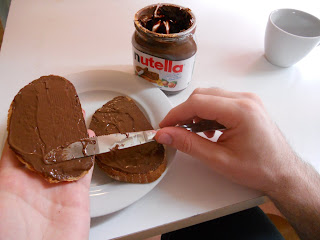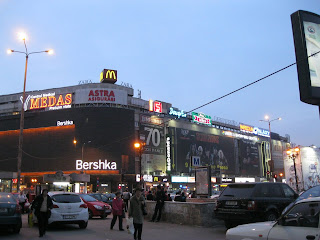Of course, the topic of the moment is Occupy Wall Street, and deservedly so. As is the case for so many people (something like 99% of them!), OWS really resonates with me—after my year of soul-searching abroad, I find myself unemployed and living in either San Francisco on my sister’s foldout couch, or in Southern California with my parents, back in the bedroom that was mine in high school.
I could elaborate the general chaos of my life at the moment, but I’ll spare you the details. In short, I’ve been living in a kind of Limbo world—it’s been challenging to maintain structure or routine, and I feel like an imposition to pretty much all of my very awesome, very patient family members. (Thanks, guys :)) I didn’t imagine it would be this hard.
But despite my circumstances, the main feelings I have right now are of urgency and optimism. Urgency not to simply find employment, but to find employment that is meaningful, and for good. And, in the course of my job search, I have derived so much optimism from the many brilliant people I’ve met, hard at work doing really important and really good work.
So in the spirit of Urgency+Optimism, I’m writing to share something completely awesome, completely free, and available to you right now on the internet: a made-for-television mini-series called Women, War & Peace. I think it’s important and I hope I can pique your interest with a summary, a hyperlink, and some notes I took on a lecture I recently attended.
(And maybe by the end of this post I can even convince you that it, too, bears relation to Occupy Wall Street—or San Francisco, or Rome, or where ever you happen to be.)
The idea of the Women, War & Peace series is that women are rarely the focus of media attention surrounding armed conflict—and yet, as Hilary Clinton says in the series’ trailer, “There are no front lines in today’s wars. The primary victims are women and children.”
Producer Abigail Disney noticed the disproportionate number of casualties among women and their lack of representation in portrayals and narratives of war. She began her film project by asking, “what if we looked at war as though women mattered?” and in conflict zones, “what are women doing?”
She believes the answers are radical and, throughout Women, War & Peace, she looks at war in Bosnia, Afghanistan, Colombia, and Liberia to understand how women’s lives are influenced by conflict and how conflict is, in turn, influenced by women.
The first installment, which aired Tuesday, October 12th on PBS, is called “I Came to Testify.” The 52-minute episode focuses on the experience of 16 women who testified at the International Criminal Tribunal for Yugoslavia (ICTY), where they told the story of the systematic rape of Muslim women as a tactic of ethnic cleansing in the 1990s war in the Balkans. Their testimonials and the international attention that they drew had the revolutionary outcome of new international laws about sexual violence in war.
Anyway, I highly recommend checking it out. You can watch the videos in full, shortly after they air for the first time on television. There will be one each week for the next four weeks, and I’m looking forward to learning more about this.
Of course, there are many things to say about “I Came to Testify,” but I thought I would write instead about what you may not be able to see yourself—a lecture I went to by Abigail Disney, who spoke at Stanford University on Wednesday, October 13th.
Disney is a very articulate and likable speaker who had a lot of interesting things to say about gender, politics, the series itself, and her experiences abroad while working on it.
I was interested to learn that Disney has a PhD in English from Columbia, where she wrote her dissertation on war novels. She likened the war novel to a “locker room conversation,” in which, she says, men address the issues of conflict with a male audience in mind and “without the fear of being overheard.” Disney talked about going to screenings of the mini-series at high schools, where boys often ask her why there are no “good” men in the movies. She responds that just as women get erased from the record of conflict, so, too, do the good guys.
For me, this led to Disney’s most interesting comments, which were about the media. When she travels, she sees two figures everywhere: Mickey Mouse and Rambo.
“Rambo is the Mickey Mouse of war,” she said, and described the effect of his pervasiveness: we all walk around with a Rambo-like image of combat in our heads, “this beautiful thing that looks and sounds like war but is actually a lot smaller, and cleaned up.”
The result? “We are getting a politics that has been shaped by the media,” Disney says. And Women, War & Peace is an attempt to push back.
Disney deploys all of the resources and mechanisms we use in the media—high production value and quality, great sound, famous narrators—to convey the importance of her subject. I really appreciate her deliberate attention to this issue of form and content, and if you check out the series I think you’ll find evidence of that thoughtfulness everywhere.
She also comments on our cultural obsession with the very content of the first episode, “I Came to Testify,” and takes a critical attitude toward “the prurient quality to how much we want to talk about rape.” But she says that rape isn’t the problem; it’s a symptom. She suggests we stop talking about it and talk instead about women’s political self-determination.
Anne Firth Murray, a Consulting Professor at Stanford and the founder of the Global Fund for Women, moderated the talk and followed up with questions after Disney spoke.
Murray’s last question of the night spoke to the optimist in everyone. She asked, “what most gives you hope?”
Disney answered by citing Paul Hawken’s book, Blessed Unrest, which I’m looking forward to checking out. She paraphrased Hawken when she said that, more than ever, people are giving up their earning potential to make positive change in the world.
For Disney, this begs the question: are we at a different historical moment? And if so, what does that mean? This movement of nonprofit work and social entrepreneurship to which she refers is dominated by women.
“We stand to come out of these years with something altogether new,” she said.
& I like it—I think it's true.

























